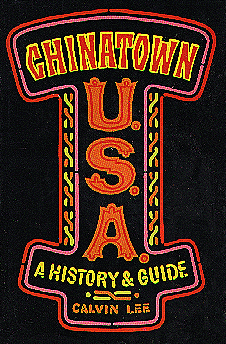GOLDSEA | ASIAN BOOKVIEW | NONFICTION
Chinatown USAby Calvin Lee
Doubleday, New York, 1965, 154pp
A History and Guide of the early Chinese settlements.
EXCERPT:
 he old-timers in Chinatown seldom, if ever, speak about the colorful days
of their youth when they first landed. When they reminisce, they talk about
the old country, the hamlets and villages where they were born. They
seldom speak of the hard times they have lived through here. Never will
they speak of the prejudices from which they have suffered. If they seem
inscrutable, if they do not become involved in the affairs of the town, it is
because of the haunting troubles of the past. Those early days of the
Chinese in this country tell a great deal about why there are so many
Chinese laundries and restaurants, and why there are Chinatowns.
he old-timers in Chinatown seldom, if ever, speak about the colorful days
of their youth when they first landed. When they reminisce, they talk about
the old country, the hamlets and villages where they were born. They
seldom speak of the hard times they have lived through here. Never will
they speak of the prejudices from which they have suffered. If they seem
inscrutable, if they do not become involved in the affairs of the town, it is
because of the haunting troubles of the past. Those early days of the
Chinese in this country tell a great deal about why there are so many
Chinese laundries and restaurants, and why there are Chinatowns.
The formal name of America in Chinese is Mei Kwok, "Beautiful Land,"
but colloquially the Chinese still refer to America as Gum San, the
"Land of the Golden Mountains," a name given by the first groups of Chinese
coming to America to discover gold in the early 1850s. Just when the
Chinese first reached America nobody knows. It may have been before the
days of the Clipper ships and the China trade of the nineteenth century.
Some archaeologists accept the Chinese symbols which are part of the lore
and dress of the Mexicans as evidence of early contact with North America.
Perhaps the Chinese cabinboy of the Bolivar who is said to have
reached California in 1838 was the first of his race to reach America. Or
were the two Chinese men and one woman whom Mr Charles V. Gillespie, a
New York merchant, and his wife brought in with a cargo of goods from Hong
Kong in 1840 the first? A colorful tale is that of Madam Ah Toy who some
say was the first Chinese woman to arrive in San Francisco. There are two
versions of the Ah Toy story. In one she was a woman of high caste and
intellect who entertained politicians and churchmen at her tea parties. In
the other, she lived in a shanty in a blind alley just off Clay Street and
displayed herself in her pantaloons of willow green silk to miners for an
ounce of gold a "look" until some miners started to cheat her by leaving
brass fillings.

Some say that Chum Ming, an enterprising man who sold tea, shawls, and other Chinese goods before he took to the hills for gold in 1847, was the person who wrote to Canton about the discovery of gold and thus started the Chinese emigration to California. The news spread in China that high wages were being paid to laborers, and circulars printed and distributed by brokers of foreign shipmasters advertised that the cost of the trip would be only $15. (Later it rose to $50.) This fare to California was three to four times less for the Chinese immigrant than for the European. Placards, maps and pamphlets pictured the Land of the Golden Mountains as a place of heaven. In 1850 forty-five vessels left Hong Kong for California with nearly five hundred passengers packed like cargo into the holds of the ships without fresh air or sunlight for the long journey across the Pacific. By the end of 1851 there were 25,000 in California.
ASIAN AIR ISSUES FORUM |
CONTACT US
© 1999-2003 GoldSea
No part of the contents of this site may be reproduced without prior written permission.
